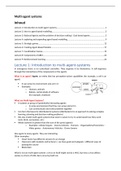Multi-agent systems
Inhoud
Lecture 1: Introduction to multi-agent-systems.....................................................................................1
Lecture 2: intro to agent based modelling..............................................................................................3
Lecture 3: Rational Agents and the problem of decision making | Goal based agents...........................5
Lecture 4: exploring and expanding agent based modelling..................................................................9
Lecture 5: Strategic games...................................................................................................................12
Lecture 6: Creating Agent-Based Models.............................................................................................17
Lecture 7: Coordination Games............................................................................................................19
Lecture 8: Components of ABM............................................................................................................23
Lecture 9: Reinforcement learning.......................................................................................................24
Lecture 1: Introduction to multi-agent-systems
In emergence there is no centralized controller. They organize it by themselves. It self-organizes
through the interactions of the components or the agents.
What is an agent? Agent: an entity that has perception-action capabilities (for example, a cell is an
agent)
It can sense its environment and act in it
Examples:
o Humans, animals
o Robots, certain kinds of software
(for example, chatbots)
What are Multi-Agent Systems?
A systems or group of (potentially) interacting agents
o In some environment that they can sense and act in
o Can communicate and solve problems together
Can form the bases for distributed AI systems (distributed AI is an approach to solving complex
learning, planning and decision making problems)
We also model multi-agent systems that exist in nature to try to understand how they work
(ants, birds, economies, etc.)
Whole (system) is greater than the sum of the parts (agents)
o Examples: cellular/organs – Insects Colonies – Humans – Organizations/Economies –
Video games – Autonomous Vehicles – Drone Swarns
One agent to many agents. They are interacting.
Other examples:
Smart home has different sensors/it can change
Classroom with students and lecturers | we have goals and subgoals | different ways of
passing the course
Blockchain
What is not an multi-agent system: a virus on itself might not be a MAS, but how a virus affects
society is a form of MAS. But a virus by itself not.
,Characteristics of MAS
Agent design: homogenous (agents that have the same properties) / heterogeneous (based on
different hardware, which can affect all functionality in multi-agent systems
Environment MAS is often dynamic (especially with learning).
Perception
o information is distributed in environment (Spatially, at a particular point / temporally /
semantically)
o Partially observable (makes action planning challenging)
Control
o Decentralized: robust, hard to divide decision-making (there is no best way. It depends
on what you want. If you want a central decision, than a decentralized structure might be
to complex because of all the different agents doing small things. But if you need to
compute something complex, it might be better if every agent does a small simple thing)
o Game theory
o Coordination games
o Different control architectures an rules are possible
o If there is an agent that want to have particular behaviour, that is control - Yash
Knowledge
o Levels of knowledge may differ
o Common or shared knowledge structures are important
Knowing what other agents know
Shared mental models, situation awareness, transactional memory system
Communication
o Two-way sender receivers
o Needed for coordination and negotiation
o Protocols for heterogeneous agents
What are the applications
E-commerce, trading, auctions
Robotics
Computer games
Social and cognitive science
Internet
Human-machine teaming
What are the challenges?
How can we understand and solve problems with multi-agent systems?
How can agents maintain a shared understanding of their environment?
How can we design agents that coordinate and resolve conflicts?
, What kind of learning mechanisms are there for agents?
How can agents of different types interact effectively?
Lecture 2: intro to agent based modelling
What is a model: an abstracted (it doesn’t exactly match with the real world) description of a
process, object, or event. Exaggerates certain aspects at the expense of others. (“All models are
wrong, but some are useful”)
What is an Agent-Based Model?
An agent is an autonomous individual element with properties and actions in a computer
simulation. (agents can be: humans, companies or governments)
ABM is the idea that the world can be modelled using agents, an environment, and a
description of agent-agent and agent-environment interactions.
Why use netlogo?
Netlogo is a premier agent-based modelling language and development environment, designed by
Uri Wilensky at Northwestern University. It is the most widely used ABM environment. It’s the
easiest to learn.
The NetLogo design principle
Low threshold
o Novices can build simple models at first use
o Pre-collegiate curriculum includes complex systems and modelling
o University courses to include model-based inquiry
o News and media to include models as evidence for arguments
High ceiling
o Language should be expressive enough to enable high end complex models
o Researchers to “read/write” and publish models
o Narrow/eliminate gap between modeler and programmer
o Enable interactive development and research
o Easy to share models
o Easy to verify and/or challenge models
Logo was first developed and is the predecessor of Netlogo. They designed a robot turtle to take
actions. When he introduced Logo to he would take that robot and talk about agents as turtles to
make the children more interactive.
A small change in a density slider for example can dramatically change the output of the system (in
this case that the fire goes all across the world). This is called a face transition.
Interface tab
Netlogo style: setup and go model. We also have:
sliders,
switches (Boolean variables, true or false),
choosers (variables that have different choices, e.g. types of trees),
input element: allows to you to put natural text on the screen
monitor: e.g. percent burned
plots: allows you to plot variables against each other
output element: it writes the output from the code





